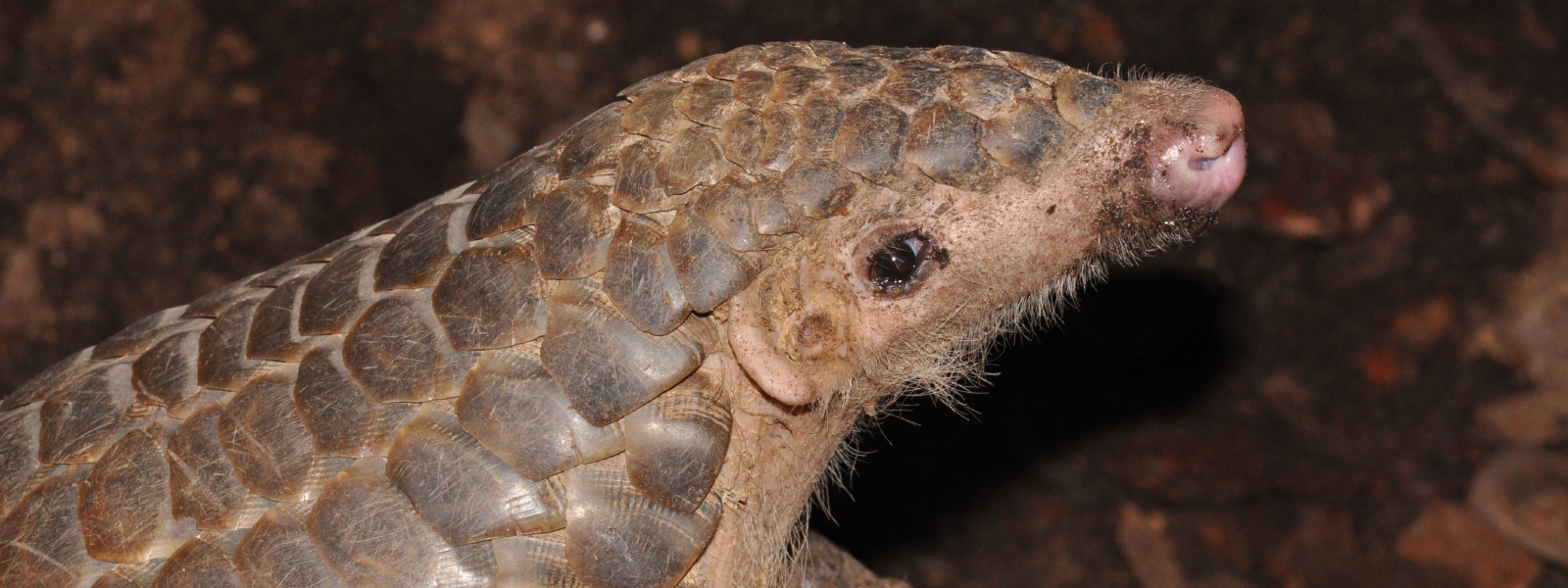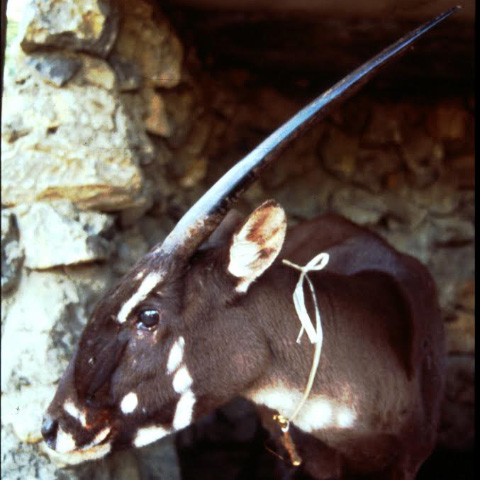Conservation Actions
The species is present in a number of protected areas across its range including in Bangladesh: Chittagong Hill Tracts, Lawachara National Park and adjacent protected areas (Trageser et al. 2017); China: Dawuling Natural Reserve; India: Vamiki Tiger Reserve (Maurya et al. 2018), Manas National Park (D. Lahkar, unpubl. data), Sirohi Wildlife Sanctuary, Bunning Wildlife Sanctuary and Yangoupokpi-Lokchao Wildlife Sanctuary (J. Sethy, unpubl. data), and Neora Valley National Park (Mallick 2010); Nepal: Kangchenjunga, Gaurishankar and Annapurna Conservation Areas, Makalubarun, Sagarmatha, Chitwan, Parsa, Shivapuri-Nagarjun, and Suklaphanta National Parks, and Royal Nagarjung Forest; Vietnam: Cuc Phuong National Park, Khe Net Nature Reserve, Ke Go Nature Reserve, Ba Na National Park, Lung Day (Cao Bo Province), Ha Nang Nature Reserve, and Pu Luong Nature Reserve (Newton et al. 2008). There are older records from Lao PDR - Nam Theun Extension Proposed National Biodiversity Conservation Area (NCBA) and Nakai-Nam Theun NCBA (Duckworth et al. 1999), and a dated record from Doi Inthanon National Park, Thailand.
Whilst the Chinese Pangolin is protected by national legislation in virtually all range states there and is included in CITES Appendix I, there remains a need to ensure effective enforcement and judicial proceedings in range states where hunting and poaching, trafficking and trade occur (Challender and Waterman 2017). Additional interventions are also needed including efforts to reduce demand for pangolin products among consumers in key markets and ensure local community buy-in to conservation efforts within and around key sites.
Research is required into the population status of this species, including population parameters and its ability to withstand current and projected hunting and poaching pressures. More comprehensive research is also required to quantify hunting pressure and national and international utilisation of this species.
Location Information
This species occurs in the Himalayan foothills of Nepal, southern Bhutan, north and northeastern India, northeast, northwest and southeastern Bangladesh, northern and western Myanmar, to northern and Annamite regions of Lao PDR and northern Viet Nam, part of northwestern Thailand, and across southern China. In China it occurs south of the Changjiang (Yangtze River) and on Hainan, Taiwan (P.R. China) and Hong Kong SAR. The species has likely been extirpated from parts of its current range, the limits of which are poorly known and may never be elucidated, due to high levels of exploitation historically. However, Taiwanese pangolin populations have stabilized in the last two decades and may even be increasing. The species occurs at high altitudes, especially in the southern and western parts of its range. In Nepal it has been recorded up to 3,000 m asl (A. Khatiwada, unpubl. data), though also occurs at much lower altitudes, for example in Hong Kong and likely in the northeast of its range. Its latitudinal range is thought to overlap considerably with that of the Sunda Pangolin Manis javanica. Where this is apparent it is hypothesized that the Chinese Pangolin occurs in hills and mountains and the former is more generally found at lower altitudes (Duckworth et al. 1999). In Viet Nam interviews with hunters in 2007 (see Newton et al. 2008) suggested that the two species can be found in the same areas of forest, and that the differences between them are ecological, relating to diet and habitat use, rather than altitude, but ecological differences between the species have yet to be fully elucidated.
In China the species' distribution extends from the southern border as far north as the Changjiang, including on the island of Zhoushan at the mouth of the Changjiang (Allen and Coolidge 1940). Its distribution extends to the provinces of Sichuan, Guizhou, Yunnan, Anhui, Jiangsu, Zhejiang, Jiangxi, Hunan, Guangdong, Huibei, Chongqing, Shanghai, and Fujian, and in the Autonomous Regions of Guangxi Zhuang, Tibet, and Hainan Island. Zhai (2000) suggest the species occurs in Xichuan county of Henan province, which would be the only record north of the Changjiang, but they provide little detail and this requires verification. In Hong Kong, the species has been recorded from the central and northeast New Territories and Lantau Island, but not on the smaller outlying islands (Shek et al. 2007); it occurs here at low altitudes (Reels 1996). In Taiwan (P.R. China), the species occurs on the periphery of the Central Mountain Range, the Western Foothill Range, the Taoyuan Tableland, the Ouluanpi Tableland, the East Coast Mountain Range, the Tatun Volcano Group, Taipei Basin, Puli Basin, and the Pingtun Plain (Chao 1989, Chao et al. 2005). The upper limit of occurrence in Taiwan is around 2,000 m asl (Chao 1989).
Beyond China, the species is distributed in northern and central Vietnam, from Ha Giang province as far south as Quang Tri Province, but is absent from the northeast coast (Newton et al. 2008). The species is found in Cuc Phuong National Park, Khe Net Nature Reserve, and Ke Go Nature Reserve, and Ba Na National Park (Newton et al. 2008). In Lao PDR, the species has been recorded in the north and central parts, but there are too few locality records to determine the geographic and altitudinal range of the species in the country with any accuracy (Timmins and Evans 1996; Duckworth et al. 1999). The species is plausibly widespread in northern Myanmar, although there are few records and its exact distribution is not well known (Salter 1983, Corbet and Hill 1992). There is a record from Karen State in the early 2010s (Moo et al. 2017). Rao et al. (2005) report a sighting of the Sunda Pangolin in Hkakaborazi NP in northern Myanmar, but there is uncertainty over the species' identification (M. Rao, pers. comm.) and it is plausibly and perhaps more likely the Chinese pangolin. There are few records from Thailand but include those from Doi Inthanon (formerly Doi Angka) in Changwat, Chiang Mai (northern Thailand), sometime in 1937 and 1939 (Allen and Coolidge 1940) and Doi Sutep, Chiangmai (northern Thailand) in 1901.
In Bangladesh, the species occurs in northern, northeastern and southeastern parts of the country, including in the border areas with northwestern Myanmar and India’s Assam, Meghalaya and Mizoram states. Two Chinese Pangolins were captured from northwestern Bangladesh in recent years but which is thought to be the result of flash flooding from India. The species has reportedly been extirpated from most protected areas in southeastern Bangladesh. However, it does occur in the Chittagong Hill Tracts (southeast), Lawachara National Park and adjacent protected areas (northeast), and Thakurgao (northwest) but has been extirpated from some areas due to poaching since around 2014 (Trageser et al. 2017). In northern Bangladesh, it may be restricted to the India-Bangladesh border area only (Trageser et al. 2017).
The species is marginally present in northern India e.g. Vamiki Tiger Reserve, Bihar (Maurya et al. 2018). There are photographic records of the species in Bihar and it has been recorded in northeastern India (Arunachal Pradesh, Assam, Meghalaya, Nagaland, Manipur, Tripura, Mizoram, Sikkim and the northern part of West Bengal) (Tikader 1983, Zoological Society of India 2002, Srinivasulu and Srinivasulu 2012). Chinese Pangolins also exist in Kaziranga-Karbi-Anglong landscape and Manas-Bhutan landscape and there are recent (post-2015) camera trap records from Manas National Park, India (D. Lahkar, unpubl. data), and reports of the species being present near Sirohi Wildlife Sanctuary, Bunning Wildlife Sanctuary and Yangoupokpi-Lokchao Wildlife Sanctuary of Manipur, India (J. Sethy, unpubl. data). The species appears to be sympatric with the Indian Pangolin (M. crassicaudata) in the Neora Valley National Park (Mallick 2010) and Manas National Park (Lahkhar et al. 2018; Goswami and Ganesh 2014).
The species occurs in southern Bhutan (though potentially central and western areas only) and Nepal, where it is typically located between 555-1740 m Asl, though there are records from 3000m Asl (A. Khatiwada, unpubl. data). A nation-wide survey of pangolins (see DNPWC and DOF 2018) in Nepal unveiled the occurrence of Chinese Pangolin throughout Nepal largely distributed in human dominated landscapes outside the protected areas, though it does occur in protected areas as well. This suggests that Chinese Pangolins are distributed across eastern, central and mid-western Nepal and the Mid hills of central Nepal harbors likely strongholds for the species. It has been recorded as present in the lower elevation belt of the Kangchenjunga Conservation Area, the Gaurishankar and Annapurna Conservation Areas, Makalubarun, Sagarmatha, Chitwan, Parsa and Shivapuri-Nagarjun National Parks, the Salyan district in western Nepal (Khatiwada et al. 2019). It has been also recorded in the Suklaphanta NP in southwest Nepal within the last four years and in Jajarkot district in mid-west Nepal (H.S. Baral, unpubl. data). In Nepal, its distribution appears to overlap with the Indian pangolin in the south and west. The Chinese Pangolin occurs from Inner Terai to hills and mountains while the Indian Pangolin is confined to lower altitudes; however, ecological differences between are not fully understood.
Geographic Range
Extant
Bangladesh, Bhutan, China, Hong Kong, India, Lao People's Democratic Republic, Myanmar, Nepal, Taiwan, Province of China, Thailand, Viet Nam
Population Information
There is very little information available on population levels at any level (local, national or global) with few exceptions, and there is a paucity of research on abundance. This species is rarely observed, principally due to its increasing rarity, but also because it is secretive, solitary and primarily nocturnal. Evidence indicates it has been extirpated from parts of its current range as a result of over-exploitation, and is otherwise in steep decline across most of its range (Zhang 2008, Nash et al. 2016, Trageser et al. 2017). An exception is Taiwan where populations are suspected to be stable and potentially increasing.
China comprises the largest range state for this species, but populations have suffered severe declines in recent decades. Between the 1960-1980s up to 160,000 Chinese Pangolins were harvested annually in China for consumptive use resulting in all but the commercial extinction of the species by the 1990s (SATCM 1996, Zhang 2008). We et al. (2004) estimated that populations declined by 88-94% between the 1960s and 1990s. In 2002, Wu et al. (2002) estimated populations in China to comprise 50,000-100,000 individuals, and in 2008 China’s then National Forestry Administration (NFA; though now National Forestry and Grassland Administration [NFGA]) estimated the national population to comprise 64,000 individuals. In contrast, Zhang et al. (2010) estimated the population in China in 2008 to comprise between 25,100 and 49,450 individuals. Also in 2008, the NFA (2008) estimated the population of Guangxi Province at 990 individuals with a density of 0.043 individuals/km². Interviews as part of research in China in recent years indicate this species is present but very rare in the border areas of Guangxi and Yunnan provinces (P.L.B. Chan, unpubl. data), but at some sites (e.g., Dawuling Natural Reserve and Luofushan Natural Reserve), new burrows have not been seen in approaching twenty years indicating extirpation, and it is suspected that the species has been extirpated from Jiangsu, Henan and Shanghai Provinces (Wu et al. 2005, Zhang et al. 2010). Between 2015 and 2016, more than 20 natural reserves were surveyed in southern China, but found no fresh burrows or live individuals (F. Zhang and Q. Wang, unpubl. data). Li et al. (2018) estimated that in eastern China (Fujian, Jiangxi and Zhejiang Provinces) the species’ range contracted by 52% between 1970s and 2000s, and populations are now largely confined to the Wuyi Mountains. On Hainan Island, extensive field research between 1997 and 2013 and interviews with hunters and local people indicate the species is of very low abundance and likely commercially extinct (Nash et al. 2016, P.L.B. Chan, unpubl. data). In Hong Kong SAR, the species is present but is considered rare (G. Ades, pers. comm).
In Taiwan (P.R. China) reports from the late 1980s and early 1990s suggest that populations of the nominal subspecies, the Formosan Pangolin were decreasing due to overexploitation from hunting and populations are were greatly reduced (Chao 1989, Chao et al. 2005). After the Taiwanese government established the Wildlife Conservation Act in 1989 it appears that domestic consumption was significantly reduced. Evidence suggests populations are stable if not increasing in Taiwan and poaching is no longer the main threat. In southern Taiwan Pei (2010) estimated densities of 12-13 individuals/km². Kao et al. (2019) estimated very approximately that the meta-population in Taiwan may comprise 15,000 individuals - though this estimate should be treated with extreme caution given significant knowledge gaps in parameters used to inform the models used to produce this estimate.
The species is very rare in Viet Nam. There are records from the past three decades from various protected areas, including Ba Na NP (Frontier Viet Nam, 1994), Cuc Phuong NP, Khe Net Nature Reserve and in Ke Go Nature Reserve (see Newton et al. 2008). However, hunters in three areas of Viet Nam reported that although they still find the Chinese Pangolin it is extremely rare and populations have declined dramatically in the last two decades (i.e. in the 1990s and 2000s; see Newton et al. 2008). In Khe Net and Ke Go, hunters reported that numbers of Chinese Pangolins were lower than those of the Sunda Pangolin probably because the former is easier to capture. If this is the case, then in places where both species occur, populations of the former are likely to be more heavily depleted (Newton et al. 2008).
The species has been so heavily hunted in Lao PDR that field sightings are exceptionally rare. There were field sightings of an individual in Nam Theun Extension PNBCA (Proposed National Biodiversity Conservation Area) in 1994-1995, and an individual was seen in a village in Nakai-Nam Theun NBCA during the same period (Duckworth et al. 1999). There are unverified camera trap records from Nakai-Nam Theun NBCA in the early 2010s (Coudrat, 2017).
In Bangladesh, Chinese Pangolins in the southeast may have disappeared (Trageser et al. 2017), however, there are still a few areas where they exist, such as within the Chittagong Hill Tracts where there is an absence of high-skilled hunters (Trageser et al. 2017). In this area, there was consensus among hunters interviewed that populations in the south has been extirpated as a result of overexploitation from poaching since 2014 (Trageser et al. 2017). Populations in Bangladesh are suspected to be declining.
This species was reported in the 1980s as common in the undisturbed hill forests of Arunachal Pradesh, however, little is known about the total population in India (Tikader 1983, Zoological Survey of India 1994). However, trafficking figures suggest this species is under severe hunting pressure in Northeast India (Misra and Hanfee 2000, Mohapatra et al. 2015, D'Cruze et al. 2018).
Surveys conducted in the Royal Nagarjung Forest in Kathmandu, Nepal, in the early 1990s determined that there was a healthy population there (Gurung 1996). Nepal's population has been loosely estimated at 5,000 individuals but is suspected to be declining as a result of overexploitation (Jnawali et al. 2011).
There is little information on the status of the species in Thailand and Myanmar. There is a potential record from Hkakaborazi NP in northern Myanmar form post-2000 (Rao et al. 2005).
Threats
The primary threat is indiscriminate hunting and poaching, both targeted and untargeted, for local and international use, with the latter primarily driven by demand in China, and the species is subject to very heavy collection pressure across much of its range (Wu and Ma 2007, Newton et al. 2008, Thapa 2013, Challender et al. 2015, Nash et al. 2016, Trageser et al. 2017, D'Cruze et al. 2018). As has occurred historically, exploitation for nutritional, medicinal and spiritualistic purposes takes place locally (Anon 1999, Nash et al. 2016, Trageser et al. 2017, D'Cruze et al. 2018). However, evidence suggests that local use is now frequently forgone in favour of entering animals into national and international trade given their high financial value (Newton et al. 2008, Thapa 2013, MacMillan and Nguyen 2014). International use involves trafficking of the species and its derivatives despite the species being included in Appendix I of CITES, the Convention on International Trade in Endangered Species of Wild Fauna and Flora. Challender et al. (2015) estimated that between 2000 and 2013 international trafficking in this species potentially involved ~50,000 individuals, though the actual number between 2000 and 2018 is higher (see Challender et al. 2019). In China and Viet Nam, the meat is consumed conspicuously as a luxury wild meat for which affluent consumers are willing to pay high prices (Shairp et al. 2016). This species also appears in both Chinese and Vietnamese traditional medicinal literature which prescribes the use of scales in traditional medicines to treat skin conditions, improve blood circulation and to stimulate milk secretion in lactating women (e.g., Chinese Pharmacopeia Commission, 2015). In China, pangolin scales also appear to be prescribed for these and other ailments, and cancer (Yu and Hong 2018), through designated outlets such as hospitals, but also through traditional medicine retailers. Since 2009 the Chinese government has released an average of 26.6 tonnes of pangolin scales from (presumably) government stockpiles on to a legal market for scales in the county (CBCGDF 2016), and which are certified through a certification system. However, this mechanism is undermined by ongoing illegal trade and availability of scales in traditional medicines shops in China (Xu et al. 2016). Ongoing but illicit availability is also the case in Viet Nam (Challender et al. 2015).Other threats include infrastructure development, habitat loss and fragmentation, and pesticide use. In China, major developments including hydropower stations and mining also pose a threat.
Taiwan and Hong Kong are exceptions where populations are not threatened by heavy hunting or poaching. The threats here include predation by feral dogs, roadkill and development, i.e. conversion of land for human use. In Taiwan, research suggests that Chinese Pangolins can become trapped in burrows or tree hollows, and is a cause of mortality, as is their capture in gin traps (Sun et al. 2019).
Partners
IUCN Red List Account Link
Please click here to see the species' IUCN Red List Account page.Photo Credits
Roland Wirth (category and featured image)












